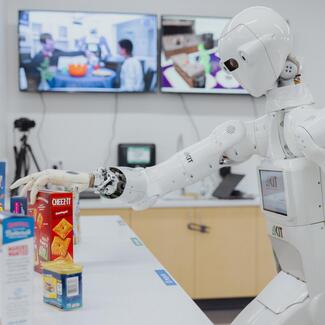
Packard’s basement unites Stanford’s robotics expertise under one roof
Stanford’s robotics researchers, once dispersed in labs across campus, now have a unified, state-of-the-art space for groundbreaking research, education, and collaboration.
The basement beneath the Packard Electrical Engineering Building, once a hallway with researchers working behind closed doors, is now a bustling hub for collaboration. After many years of planning, fundraising, and development, the all-new Stanford Robotics Center officially opened its doors with a reception Nov. 1.
The new facility is a bright, open, and vibrant space with a number of research bays arranged side-by-side. In one corner, a dancer pirouettes as her movements are digitized and projected on a nearby monitor. Next door, a pair of robotic arms makes a bed while others prepare a meal. Not far away, a medical student gazes into stereoscopic lenses manipulating hand tools while a machine across the room performs a mock surgery.
“I came to Stanford in 1981 and this idea – this dream – was always there, even then,” says Oussama Khatib, director of the new Stanford Robotics Center and mastermind of the design and transformation of the space. “Robotics cannot really be successful unless we bring all the different research areas of robotics together: mechanical engineering, computer science, materials science, electrical engineering, artificial intelligence. There are so many connections between what we all do that we really needed one place to call home.”
Khatib, a professor of computer science, has made headlines with several robots in his more than four decades at Stanford. The best known is perhaps his humanoid OceanOne submersible robot that helped explore shipwrecks and deep-sea coral reefs without risk to human divers.
Excerpted from Stanford Engineering's, New center unites Stanford’s robotics expertise under one roof by Andrew Myers